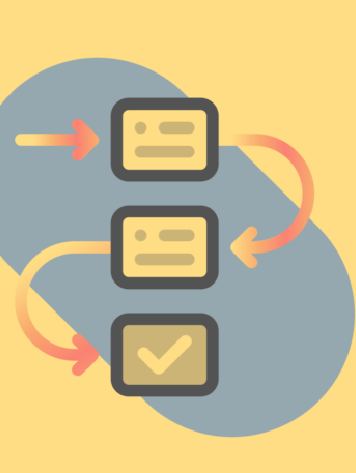By William J. Francis
From small to large projects, a workflow template can help you identify everything needed to complete a project. This guide covers the six steps for creating a successful project management workflow.
When you’re working on a project, being organized and approaching the task methodically ensures consistent, timely results, and the best way to do that is through workflow management. The following step-by-step guide walks you through the process of creating a project management workflow template that you can implement for all your future projects.
What is workflow management in project management?
Workflow management refers to the identification, organization and coordination of the set of tasks that result in a specific outcome. When done correctly, workflow management will ensure you get to the desired outcome as quickly and efficiently as possible. If you are new to the topic of workflow management, comparing and contrasting it to project management is a good place to start.
What is workflow vs. project management?
Project management is the science of all the things it takes to complete a project or task. By providing transparency to all aspects of the project, formalized project management seeks to answer what is going to be delivered, by whom and when.
Workflow management is the next layer of detail below project management. While project management is broad, workflow management is more narrowly focused. Workflows are the specific, sequenced steps required to complete a task or project. In short, while project management is charged with answering what, who and when, a workflow is primarily focused on the how.
Why is project management workflow important?
It is entirely possible to deliver a project without workflow management. That said, it’s not recommended.
While you can make a reasonable argument that as you deliver the project the workflows will emerge, failure to manage your workflows will result in missed dependencies, which manifest as delays and work stoppages. This lack of efficiency will make it difficult to answer when a project will be complete, one of the desired outcomes of good project management.
The goal of workflow management is to create efficient, repeatable ways to get work done. The repeatable aspect is especially important if you manage similar types of projects. For example if you are part of a team that primarily delivers software, you’ll find that once you have a good workflow defined, your ability to predict the other aspects of project management such as resources and timelines will greatly improve.
At the end of the day, the best project managers utilize project management and workflow management to successfully deliver a project.
How do you build a project management workflow?
There are a number of good project management software tools on the market to help you create your project management workflow. Products like Jira, Smartsheet and monday work management all have a number of templated workflows you can use out of the box or customize.
You don’t necessarily need any tools other than a pen and some paper to design your project management workflows. Here are the steps we recommend.
1. Tasks
The first action for designing a project management workflow is thinking through all the steps required to complete your project. It’s important to think categorically versus discreetly. For example, a typical software workflow might consist of:
- Interviewing stakeholders
- Creating wireframes
- Building the software
- Testing
- Deploying
These are repeatable steps you could apply to multiple projects. As you are documenting your task list, try your best to sequence the items chronologically, as this will be handy later.
2. Resources
After you’ve detailed the tasks required to complete your project, it’s time to consider what sorts of resources you’ll need to get it done. These usually fall into the categories of tools and people. If you are delivering software, you’ll need developers and visual designers. Make sure you not only list out all the resources required but highlight gaps, or areas where you are missing the people and/or tools needed to be successful.
3. Deliverables
Just to make sure you haven’t left any critical steps out of your workflow, it’s a good idea to jot down exactly what the output from your project will be. For example, if you are designing a new report for the accounting team, your deliverables might be the new reporting software itself, documentation on how to use that report and a training class to teach the accounting team how the new software works.
Going through this thought process might cause you to reevaluate the tasks and resources you’ve identified previously. Maybe there should be a documentation task between the build and test steps. Or maybe you need a change manager as a resource on your team to successfully deliver the training.
4. Roles and assignments
With your list of tasks and required resources determined, decide who will contribute to which tasks to complete your project. Remember, the goal is to design a reusable workflow, not a specific project plan. Therefore, think roles like user experience designer instead of names like Tracy from creative.
5. Diagram your workflow
It can be especially effective to visualize a project management workflow. There are a number of ways you can visualize the workflow from a flow chart to Gantt chart. The table below is an example of an easy way to diagram a project management workflow. Across the x-axis, we have laid out all of our tasks, chronologically. On the y-axis, we’ve detailed the required resources at each step. In our example, those resources are people, but they could consist of people, tools or both.
| 1. Interviews |
2. Wireframes |
3. Development |
4. Test |
5. Deploy |
| CX researchers |
Visual designer and information architect |
Engineering manager, developers and tech architect |
Manual tester and automation engineer |
DevSecOps engineer |
With this visual representation, it becomes more clear both the sequence of the tasks, and any dependencies between them.
6. Iterate
Last but not least, don’t let perfection get in the way of good enough. It’s unlikely you’ll get everything right with your project management workflow the first go round. Don’t let that stop you from putting it into practice. If you constantly inspect and adapt along the way, in no time your project management workflow will be humming.
By William J. Francis
Sourced from TechRepublic



